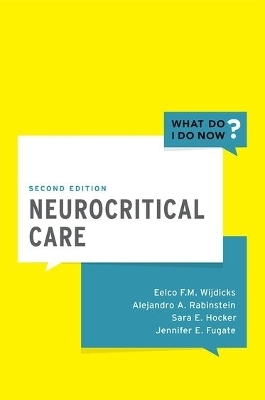
Neurocritical Care
Oxford University Press Inc (Verlag)
978-0-19-060265-9 (ISBN)
EELCO F. M. WIJDICKS, MD, PhD, FNCS is a Professor of Neurology, the Chair of Critical Care Neurology, and a consultant in the Neurosciences Intensive Care Unit at the Mayo Clinic Campus, Saint Marys Hospital in Rochester, Minnesota. ALEJANDRO A. RABINSTEIN, MD, FNCS is a Professor of Neurology, in the division of Critical Care Neurology, the Medical Director of the Neurosciences Intensive Care Unit, and a Consultant in the Neurosciences Intensive Care Unit at the Mayo Clinic Campus, Saint Marys Hospital in Rochester, Minnesota. SARA E. HOCKER, MD is an Assistant Professor of Neurology in the Division of Critical Care Neurology, the Director of the Neurocritical Care Fellowship Program, and a Consultant in the Neurosciences Intensive Care Unit at the Mayo Clinic Campus, Saint Marys Hospital in Rochester, Minnesota. JENNIFER E. FUGATE, DO is an Assistant Professor of Neurology in the Division of Critical Care Neurology and a Consultant in the Neurosciences Intensive Care Unit at the Mayo Clinic
Section I: Acute Interventions
1. Rapid Progression in Lobar Cerebral Hemorrhage
2. Cerebral Hemorrhage and High INR
3. Traumatic Brain Injury Arriving in the Emergency Department
4. Meningitis Not Improving After IV Antibiotics
5. Acute Encephalitis and Abnormal MRI
6. A Psychotic Break and Seizures
7. Acutely Progressive Dyspnea and Limb Weakness
8. Swollen Lips After IV Thrombolysis
9. When to Retrieve a Clot in Acute Stroke
10. Swollen Ischemic Brain and When to Call the Neurosurgeon
11. Cerebral Venous Thrombosis Not Responding to Anticoagulation
12. The First Week After Aneurysmal Subarachnoid Hemorrhage
13. The Neurointerventionalist and Aneurysmal Subarachnoid Hemorrhage
14. A Worrisome MRI Of The Spine and Prior Cancer
15. Acute Paraplegia After Aortic Surgery
16. When Status Epilepticus Becomes Treatment Refractory
17. Medical Options in Brain Metastasis
18. Hemorrhage Into a Pituitary Tumor
19. Brain Edema and Hypertensive Urgency
20. Rare Toxicity After Chemotherapy
21. Failure To Awaken After Surgery
22. Awake and Then Not Awake After Uncomplicated Brain Surgery
Section II: Monitoring 101
23. When a Spot EEG is Not Enough
24. When an Intracranial Pressure Monitor is Helpful
Section III: Calls, Pages, and Other Alarms
25. Wild and Agitated After Acute Abdomen
26. Rigidity After Experimenting with Drugs
27. Sweating, Fever and Hypertension after Traumatic Brain Injury
28. Acute Fever and Profound Shock After Ruptured Cerebral Aneurysm
29. Coma and Chest X-Ray White-Out After a Fracture
30. When Blood Pressure Needs Control After Stroke
31. A Common Cardiac Arrhythmia After Stroke
32. Hypertension And Bradycardia in Severe Guillain Barré Syndrome
33. Myasthenia Gravis Improved but Not Off the Ventilator
34. Decreasing Serum Sodium in Aneurysmal Subarachnoid Hemorrhage
35. Increasing Serum Sodium After Surgery for Tumor in The Pituitary Region
Section IV: Longterm Support, End Of Life Care, and Palliation
36. Care of a Persistently Comatose Teenager
37. Withdrawal of Care in an Elderly Person with Catastrophic Brain Injury
38. Not Yet Brain Dead
39. When to Mention Organ Donation
Section V: Principles of Prognostication
40. What Neurologists Know About Outcome in Traumatic Brain Injury
41. What Neurologists Know About Outcome in Post Resuscitation Coma
| Erscheinungsdatum | 30.04.2016 |
|---|---|
| Reihe/Serie | What Do I Do Now |
| Verlagsort | New York |
| Sprache | englisch |
| Maße | 234 x 155 mm |
| Gewicht | 726 g |
| Themenwelt | Medizin / Pharmazie ► Medizinische Fachgebiete ► Neurologie |
| Medizin / Pharmazie ► Medizinische Fachgebiete ► Notfallmedizin | |
| ISBN-10 | 0-19-060265-1 / 0190602651 |
| ISBN-13 | 978-0-19-060265-9 / 9780190602659 |
| Zustand | Neuware |
| Haben Sie eine Frage zum Produkt? |
aus dem Bereich


